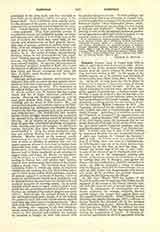

Dandolo, ENRICO, Doge of Venice from 1192 to 1205; d., aged about a hundred years, in 1205. He belonged to one of the electoral families who claimed descent from the twelve tribunes by whom the first doge had been elected in 697. In the course of the twelfth century one of his relations was Patriarch of Grado for fifty years (Mon. Germ. Hist.: Script., XIV, 71). Of his life, we only know the role he played in history, but he appears to have been a man of uncommon physical and mental strength. At the age of almost a hundred he took the cross, and led the expedition against Constantinople; a fearless knight and the first to scale the walls of a city, he was also a distinguished diplomat, and his influence seems to have been predominant in the Fourth Crusade. He is first mentioned as taking part in the war between Venice and the Emperor Manuel Comnenus in 1171. The Venetians, decimated by the plague, were at Chios, and Dandolo was sent to Constantinople to make a treaty of peace. According to a tradition quoted by the “Chronicle of Novgorod”, the emperor burnt out his eyes. Andrea Dandolo (1307-1354), a descendant of the same family, makes the statement that he was partly deprived of his sight in the service of his country (pro salute patriae constanter resistens, visu aliqualiter obtenebratus est, “Chronic.”, ed. Muratori, xii, 298). It would seem that in spite of all the torture he underwent Dandolo was not completely deprived of sight (see Luchaire in “Journal des Savants”, 1907, p. 110). In 1172 he went on a mission to William II of Sicily, then once more to Constantinople. In 1178 Dandolo was one of the forty electors commissioned, for the first time, to elect the doge. He himself was elected doge in his turn (June 1, 1192). In spite of his advanced age he displayed great activity, put an end to the commercial quarrels with Verona, declared war against the inhabitants of Zara for uniting their city to Hungary, and against the Pisans, who had attempted to establish themselves in Istria. In 1198 he concluded a treaty of alliance with the Emperor Alexis III of Constantinople, but as early as 1201 Venice had disagreements with Alexis, who broke all his promises and granted numerous privileges to the Genoese and the Pisans.
At this time (March, 1201) the leaders of the Fourth Crusade came to negotiate with Venice for the transport of the troops to the Orient; Dandolo himself took the cross as well as several other Venetian nobles. In consequence of circumstances not yet clearly explained, the crusade, originally directed against Egypt, was turned first against Zara and then against Constantinople. Streit (Venedig and die Wendung des vierten Kreuzzuges, 1877) attributes to Enrico Dandolo the principal role in the intrigues which preceded these events. Riant (Revue des questions historiques, XXIII, 109) has pointed out very truly that the initiative of the doge was strictly limited by the Constitution of Venice. If Dandolo directed the negotiations he did it in agreement with the councils of Venice. With this reservation it may be admitted that Dandolo took the leading part in the negotiations which ended in the capture of Constantinople. In fact it was to the interest of Venice to reestablish order and security in the Byzantine Empire. Dandolo proposed the expedition against Zara (October, 1212) to the crusaders, as a way to pay off their debt to Venice. In the council of war held after the capture of Zara, according to the testimony of Robert de Clare, Dandolo was the first to suggest that the preliminary occupation of Greece would greatly facilitate the conquest of the Holy Land. Thereafter, during the entire expedition, his influence over the leaders of the Crusade grew from day to day. He presided at the council of war held at the Abbey of San Stefano, June 23, 1203, and gave the wisest advice to the barons. In spite of his age he took an active part in the operations of the siege of Constantinople. While the barons attacked the walls in the Blachernae quarter, Dandolo directed the assault of the Venetians against the sea walls and hoisted the gonfalon of St. Mark on his galley. The city captured, he wished to force Alexis IV to keep the promises made to the crusaders. Upon his refusal, Dandolo boldly defied him and advised the barons to undertake a second siege of the city. In the council of war, March 1, 1204, Dandolo signed with them the treaty partitioning the empire between Venice and the crusaders.
After the capture of the city he had Boniface of Montferrat driven out of the empire; the barons offered him the imperial crown, but he loyally refused it, so as not to violate the Constitution of Venice. The new emperor Baldwin gave him the title of “Despot”, and he settled in Constantinople. In 1205 he took part in the disastrous expedition against the Bulgarians; he died shortly afterwards and was buried in St. Sophia. Dandolo by his skill and energy established the political and commercial power of Venice in the Orient.
LOUIS BREHIER

